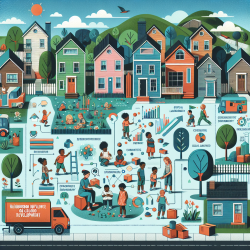Introduction
In recent years, the impact of neighborhood socio-economic conditions on child development has gained increasing attention. A recent study titled "Neighborhood and Child Development at Age Five: A UK–US Comparison" provides valuable insights into how neighborhood environments influence cognitive and behavioral outcomes in children. This blog aims to help practitioners improve their skills by implementing the findings of this research or encouraging further exploration in this area.
Key Findings
The study utilized data from two longitudinal studies: the UK Millennium Cohort Study and the Fragile Families and Child Wellbeing Study in the US. It examined cognitive and behavioral outcomes of children at age five in relation to neighborhood composition, family circumstances, and residential mobility. The research highlights several key findings:
- Neighborhood Advantage: There is a strong association between cognitive scores and neighborhood advantage in both the UK and US. Children living in more advantaged neighborhoods tend to have higher cognitive scores.
- Family Circumstances: While neighborhood advantage plays a significant role, family circumstances also influence cognitive outcomes. However, the impact of neighborhood advantage is not entirely eliminated by family factors.
- Behavioral Outcomes: The association between neighborhood advantage and behavioral problems is less pronounced compared to cognitive outcomes.
- Residential Mobility: Changes in neighborhood disadvantage due to residential mobility show mixed effects on children's development. The study suggests that the timing and nature of neighborhood changes are crucial.
Implications for Practitioners
For practitioners working with children, these findings underscore the importance of considering neighborhood contexts when assessing and planning interventions. Here are some ways practitioners can apply these insights:
- Holistic Assessment: Incorporate neighborhood factors into the assessment of children's developmental needs. Understanding the socio-economic context can provide a more comprehensive picture of the child's environment.
- Targeted Interventions: Design interventions that address both family and neighborhood factors. Collaborate with community organizations to create supportive environments that promote positive developmental outcomes.
- Advocacy and Policy: Advocate for policies that improve neighborhood conditions, such as access to quality childcare, recreational facilities, and educational resources. Support initiatives that reduce residential segregation and enhance neighborhood stability.
Encouraging Further Research
While this study provides valuable insights, there is still much to learn about the complex interplay between neighborhoods and child development. Practitioners are encouraged to engage in further research to explore:
- The long-term effects of neighborhood changes on child development.
- The mechanisms through which neighborhood factors influence cognitive and behavioral outcomes.
- Comparative studies across different cultural and socio-economic contexts.
To read the original research paper, please follow this link: Neighborhood and Child Development at Age Five: A UK–US Comparison.










